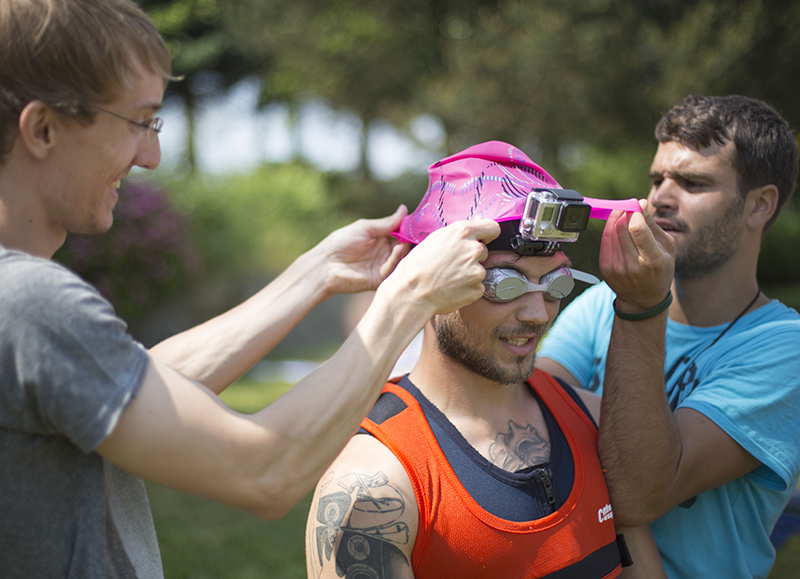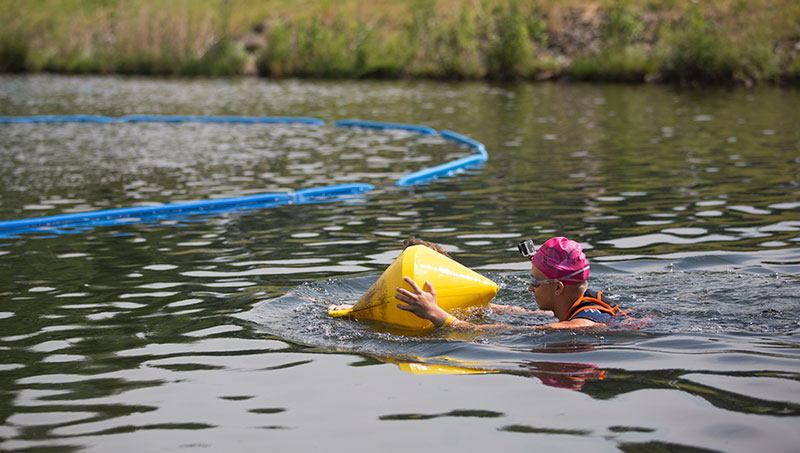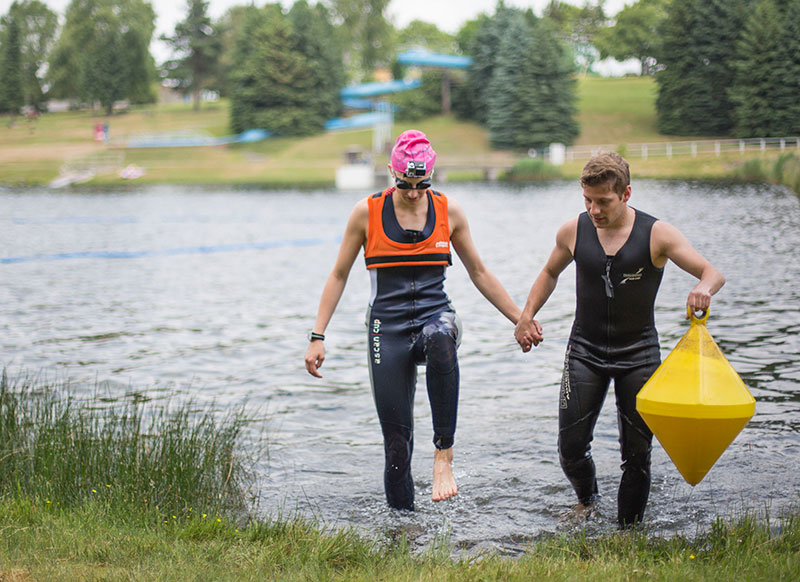Scientists send students into the water maze
Chair of Sports Medicine/Biology at the TU Chemnitz transmits test for orientation ability from mice to humans – with data collection in water, on the sports field and on the computer
-

The experimentees are equipped with a helmet camera and a heart rate belt. Scientists detect, inter alia, the distance traveled and the time required for locating the target position. Photo: Andreas Grünewald -

The tests take place in the reservoir of Rabenstein in a circular area with a diameter of 18 meters. Photo: Andreas Grünewald -

After the experimentee has found the required platform for the first time, he puts on darkening glasses not to be able to accommodate any further information for orientation. In the following three passages the target position must be retrieved each time within five minutes. A lifeguard provides security during the study. Photo: Andreas Grünewald
Sport is not only good for the physical shape of humans, but also for their mental condition – this thesis is investigated by scientists of the Chair of Sports Medicine/Biology at Technische Universität Chemnitz for the last year and a half. The focus of the research team is adult neurogenesis, that is, the new formation of nerve cell in the adult brain. The findings can find future application in the treatment of degenerative diseases. In this context, the scientists, in cooperation with the German Center for Neurodegenerative Diseases (DZNE) in Dresden, investigate whether the “Morris water maze”-Test for mice can be transferred to humans. The swim test serves to verify the orientation/navigation performance and, thus, the brain area of the hippocampus in laboratory rodents. The researchers from Dresden have already developed a computer-based test for spatial learning of humans in this context. “In this computer test, however, the question arises, how valid the navigation ability of humans can be detected in realworld environments,” says Dr. Peter Wright from the Chair of Sports Medicine/Biology. Hence, the scientists now send 27 sports students of the TU Chemnitz swimming in the lake of Rabenstein/Chemnitz.
From Laboratory Rodents to Humans: Scientific Gold Standard is tested
In the “Morris water maze”, mice need to find an invisible platform in a swimming pool, remember their position and then find it again. “The water maze has become the gold standard for noninvasive testing of the function of the hippocampus of mice and is being used for more than 30 years,” says Jacqueline Böhr, academic member of staff at the Chair of Sports Medicine/Biology. To solve the task, the animals use visual landmarks to navigate, on the basis of which a cognitive map is created, and the mice can retrieve the target from different starting points. The “Dresden-Spatial-Navigation-Task” test, developed at the German Centre for Neurodegenerative Diseases virtually maps the scenario. “The results of the first computer-based study suggest that the spatial behaviour strategies between a mouse and a human are comparable, and that the spatial learning of older people can be improved by physical training,” says Dr. Alexander Garthe from the DZNE. The scientists from Dresden developed a method of data analysis that allows an assessment of the spatial learning task in an unprecedented level of detail.
Now, in June 2014 in Chemnitz a research project is being conducted, which consists of three tests and should validate the Dresden-Spatial-Navigation-Task. In Rabenstein Lake, 27 subjects will swim in a circular area with a diameter of 18 meters in order to find a target position and retrieve it. For comparison, there will be another test under similar conditions on land. The subjects traverse in walking speed a large area on a sports field of the university at the Thüringer Weg. “If this test-setup produces the same results, this so-called Dry-land Version of the tests would be better used in the future than its equivalent in the water,” explains Wright. The third step is the computer-based test completed by the sport science students. In all three experiments, the subjects conduct four test runs. The first one is for general orientation in the area. If a subject does not find the target, it is made visible. In the following three runs the subjects have five minutes to locate and renewed search for the target position.
In all three tests the distance traveled and the time required for finding the target position are is measured. “The strategy of the subjects is of a particular interest for us. We look especially at how through the process of several runs the knowledge and/or information is gained in order to find the target position again. Here the acceleration data of walking and swimming helps,” says Böhr. For this purpose a tracking system and video recording is used. Additionally, the subjects are equipped with a helmet camera and a heart rate monitor. To control any related side effects caused by the water temperature in the lake, the subjects wear wetsuits. Also a lifeguard and a paramedic are present during the test. “This experiment in the water is extremely complicated, especially when we take the equipment used into account. That is why the transfer of this test from mice to humans, has never been done before,” emphasises Wright.
Running vs. Drumming: Ongoing Evaluation of Pilot Studies
Since spring 2013, scientists from Chemnitz and Dresden have already conducted two neuroscience pilot studies. Both studies investigated the effects of physical activity on spatial learning and brain plasticity. “The extent to which different exercise intensities and the duration affect the spatial learning was first examined,” says Wright and adds: “The analysis of the data is still ongoing. But, we can already say that endurance training has a positive effect.” Secondly, two forms of stress were compared. While one group of subjects had to run on a treadmill, the other had less physiological stress, but had to undergo a highly demanding coordination training as an intervention: The subjects learned to play drums (percussion). “Drumming and percussion, which has been a research focus of us for years in the project `The Drum Beat´, has positive effect on brain function,” says Dr. Peter Wright.
You can also obtain further information from Dr. Peter Wright, Phone +49 371 531-35590, Email peter.wright@hsw.tu-chemnitz.de, and Jacqueline Böhr, Phone +49 371 531-39284, Email jacqueline.boehr@hsw.tu-chemnitz.de .
(Author: Katharina Thehos, Translation: Nataliia Boiko)
Mario Steinebach
15.06.2014





